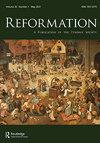Marketing English Books, 1476-1550
IF 1.1
0 RELIGION
引用次数: 0
Abstract
framework to analyze how images can construct meaning and both prompt and evade interpretation. It probes at central issues related to audience, publics, reception, artistic intent, and fundamentally how images communicate. The book situates Dürer at the nexus of these developments due to his unique positionality and artistic identity. Yet the book also suggests that the epistolary mode goes beyond Dürer. A question remaining at the conclusion of reading is how the epistolary mode might be identified in images without an overt connection to the type of epistolary activity that Dürer engaged in, and how Brisman’s framework might be adapted as a broader interpretative tool. The author makes clear that just because a letter appears in a work of art does not mean it engages in the same construction of meaning as Dürer’s works. Indeed, an interesting sub-theme of the book is to mark the historical specificity of this mode, shown to hinge on a confluence of factors that included the new postal service, printmaking, the Reformation, and an artist who was himself particularly engaged in the practice of letter writing. As Brisman shows, letters in seventeenth-century art mean something quite different than they do in Dürer’s works due to changes in notions of intimacy, the function of letters, and gendered shifts in letter writing. At the same time, Brisman concludes with the intriguing statement that “the epistolary mode is evident wherever the work of art is, on the one hand, hopeful about what it might be – the kinds of connectivity it might yield – while, on the other hand, mournful about what it is not” (180). The book presents a probing and enlightening discussion of Dürer’s works, his artistic and literary practice, and his means of address to his various publics.营销英语书籍,1476-1550
分析图像如何构建意义以及提示和回避解释的框架。它探讨了与观众、公众、接收、艺术意图以及图像如何传播有关的核心问题。由于他独特的地位和艺术身份,这本书将他置于这些发展的联系之中。然而,这本书也表明,书信体模式超出了文学的范畴。在阅读结束时留下的一个问题是,如何在图像中识别书信模式,而不与 rer所从事的书信活动类型有明显的联系,以及布里斯曼的框架如何被改编为更广泛的解释工具。作者明确指出,仅仅因为一个字母出现在艺术作品中,并不意味着它参与了与勒尔作品相同的意义构建。事实上,这本书的一个有趣的副主题是标记这种模式的历史特殊性,它取决于一系列因素的融合,包括新的邮政服务、版画、宗教改革,以及一位自己特别从事写信实践的艺术家。正如布里斯曼所展示的那样,由于亲密观念的变化、字母的功能以及写信的性别转变,17世纪艺术中的字母与雷尔作品中的字母有着完全不同的含义。与此同时,布里斯曼总结了一个有趣的说法,“无论艺术作品在哪里,书信模式都是显而易见的,一方面,对它可能是什么充满希望——它可能产生的各种联系——同时,另一方面,对它不是什么感到悲伤”(180)。这本书提出了一个探索性的和启发性的讨论,探讨了德勒的作品,他的艺术和文学实践,以及他对各种公众的讲话方式。
本文章由计算机程序翻译,如有差异,请以英文原文为准。
求助全文
约1分钟内获得全文
求助全文

 求助内容:
求助内容: 应助结果提醒方式:
应助结果提醒方式:


